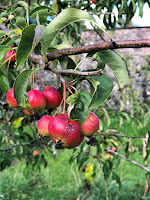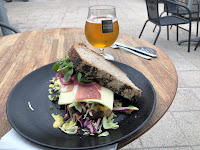Pretty much packed and ready to go, I woke on Sunday morning to the most glorious day of sunshine in Copenhagen. I had breakfast, showered and set off for Mass at the cathedral. From a few blocks away, I could hear the bells. It was
nice to hear church bells. I don’t think I had ever heard them anywhere else we
were. There was a fairly large number of people already in church a little
before 10:00. On the website, the Mass was listed as Latin on the 1
st
and 3
rd Sunday. I was a little anxious that it would be the
extraordinary form (Tridentine Mass); but it wasn’t. It was the regular Mass
but with Latin chant music. The spoken parts were in Danish, though. At least I
understood the Latin! As you would expect in a setting where Catholics are a distinct
minority, participation was very high and people seemed quite engaged. I was
surprised when I saw the time after Mass, I had to hustle back to the hotel and
get to the airport.
 |
| St. Ansgar Cathedral, Copenhagen |
I checked out of the hotel and had them call me a cab.
Fortunately, Copenhagen’s international airport is relatively close to the city
center, closer than almost any other capital that I can think of. I had a nice
young cabbie and a pleasant conversation. Everyone speaks English so well! I
was lucky enough to have enough cash to pay the fare. I didn’t want to have a
lot of Danish kroner left over.
Inside the terminal it was a madhouse. I was
flying SAS and they only have self-check in for economy. When I finally got the
kiosk to cooperate, it informed me that I was being put on stand-by and that I
had a boarding pass but not a seat assignment. AAAARGHHHH! It also said that I
had to see an agent. The flight was overbooked and they were looking for
people to give up their seat. I was probably never going to be able to use an
SAS credit, so I decided against it, even though I could have. Fortunately, I never had to worry about
it. The agent told me that I would be given a seat at the gate. I mistakenly thought that I
was going to have time for a leisurely lunch at the airport, but then I saw
that I had to go through passport control, which was odd. That was another mob
scene, especially for non-EU citizens. By the time I got to the gate, they were
almost ready to begin boarding. I retraced my steps (Copenhagen airport is
really spread out!) and grabbed a sandwich and a bottle of water. Boarding had
already started when I got back to the gate. My seat was in the last row – but
at least I had a seat. . . and my lunch.
 |
| Sunny Dublin! |
The flight was fine and uneventful. We landed in Dublin
under sunny skies and warm temperatures, high 70’s. You can log some miles on
the ground in Dublin’s airport too. Of course, there’s no air-conditioning and
even though it wasn’t hot, hot, it was still uncomfortable. Once again, I had
to go through passport control, and once again, it was a zoo. Just like in the
supermarket, I always seem to get in the wrong line. The two college-aged girls
ahead of me seemed to be having some entry/visa issues. It took lots of chatter,
inspecting of papers, stamping and more chatter before the issue was resolved.
I walked up to the window and slid my password forward to the agent. She looked at it and
said, “Paul, I’ve been waiting all afternoon for you to show up.” To which, I
said, “Is that why you took so much time with the girls ahead of me?” When I
saw the smile, I knew I was OK. This is what I love about Ireland - the verbal
play that is so much a part of the culture. After a few more questions, she
stamped my passport and I was on my way.
We were in passport control for so long that most of the
bags from our flight were already gone. I grabbed mine and headed outside to grab a
cab. The line for cabs was unbelievable! It took at least 20 minutes to get
one. When I was finally inside, it was a relief. My cabbie was great! He was
your stereotypical Irishman – a great talker. By the time we got to the city,
he knew my life story. Besides the beautiful weather, Dublin was in a festive
mood, because their Gaelic football team was in the midst of the championship
match with Co. Tyrone. Every drinking establishment we passed on the way was
festooned with the colors of one or the other (or both) teams. At this point,
he asks, “So, d’ya drink whiskey?” To which I reply, “I’ve been known to take a
drop.” He then lists several pubs
 |
| Did someone say "Guinness"? |
where I should go and taste. To which I say, “In
this heat, I really want a cold beer.” “A Guinness?” he asks. I say, “Not in this
weather, but I don’t know what to ask for.” He says, “Sure, all you have to do
is ask for a pint of lager.” As we turned the corner towards my hotel, he
pointed out the window at “The Long Hall” and said. “If you want a pint, that’s
where I’d go.” For that tip, I gave him a nice tip. In parting, he said, “I’ll have a pint on you.”
I checked into the hotel where I have stayed before. It’s a
pretty basic place, but it’s in a great location. I was half hoping that there
would be a mini-bar with a beer in it, but alas. As it turned out, though, there
was a pub on the same corner as the hotel. I went in, sat at the bar, and
noticed that I had just raised the average age by about 40 years. Oh well. The
pub had a great assortment of artisanal beers and I ordered a local India Pale
Ale. There is nothing quite like the first swig of a cold beer on a hot day.
Despite being a little out of place, I enjoyed my beer and went back to the
hotel to take a shower.
The last time I stayed at this hotel, I discovered a
very nice French bistro just one block away. I liked it so much that I ate
there twice. Since it was Sunday, I decided to check and make sure that it was
open. When I did check on TripAdvisor, I saw that it was open. I also saw that
there were a lot a fairly negative reviews – not so much about the food, but
about the way customers were treated. As a frequent solo diner, that was a red
flag for me. Any place that feels it can turn away customers is not likely to
want to give a table to just one customer. I decided to look elsewhere. Fortunately,
I found another French place almost as close. It had great reviews and even
allowed me to book a table on line. I was all set for this evening.

















































